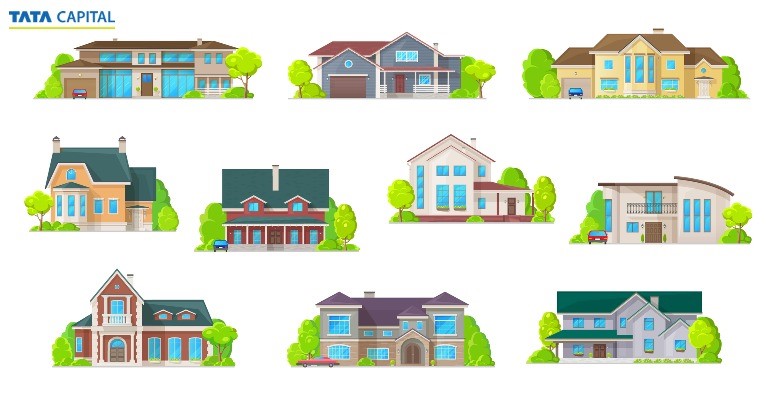Tata Capital > Blog > Loan for Home > Difference Between Home Extension Loan And Home Loan Extension
A home loan extension is an extension of tenure to repay an existing loan. When a home loan debtor may not be able to pay the EMIs in the agreed duration under certain circumstances, they might consider a home loan extension. This provides relief for the debtor. On the other hand, any person who wishes to extend their existing house to increase its living space can apply for a home extension loan. A debtor can get these loans for a maximum tenure of 20 years for up to 90% of the construction estimate. This article decodes what home loan tenure, home extension loans, home loan duration, tips on extending their house, and more are.
A home loan is one of the biggest liabilities one will ever face in their lifetime. Apart from being the longest-tenured loan. It also has the highest interest rate. Therefore, most home loan borrowers are constantly seeking ways to reduce the amount they pay on their equated monthly installments (EMIs).
One can consider extending their home loan tenure if they are under financial stress and want to reduce their EMI. When one’s home loan has 10 years left to run at 7.5% and the tenure is extended to 20 years, one can save Rs 15,257 on one EMI.
In addition to applicable taxes, loan processing fees are charged as a percentage of the loan amount. In addition to advocate fees (if applicable), property insurance premiums, and stamp duty charges for loan agreements, there may also be other charges.
Applicants who are salaried and self-employed must provide these documents:
A home loan extension offers short-term relief if the borrower is on a tight monthly budget. By extending the tenure of their home loan, borrowers can minimize the monthly deductions. However, this may also lead to a higher interest amount the borrower will pay in the entire tenure.
The interest payment on a home loan can be tax-deductible if one chooses a longer repayment period. Because there are no alternative tax benefits as efficient as those on home loan interests, one should take advantage of them for as long as possible. Under Section 80C of the Income Tax Act, one can deduct up to Rs.1.5 lakh for repayment of the principal component of a housing loan. A short repayment period will result in a higher principal component, and one will not be allowed to deduct above the specified limit for a short repayment period. Therefore, a home loan extension is preferred when it comes to getting tax benefits.
Home loan extension gives a great deal of flexibility to the borrowers while repaying their loans. Home loans are available with fixed or floating rates of return, and prepayment is not penalized. Prepaying the entire loan amount or a portion of it can lead to debt freedom. Debtors can repay the loan based on their cash flow with the option of prepayment without paying the penalty.
The extended repayment tenure allows the borrower to qualify for a greater loan amount, A long repayment tenure also allows one to qualify for a greater loan amount. A long tenure also means a lower EMI since their home loan eligibility depends on their ability to repay the loan amount through Equated Monthly Instalments (EMIs). A shorter tenure will require the debtor to repay the borrowed amount in large EMIs, which is not the case when one opts for a shorter tenure. If borrowers choose a longer loan term, lenders will also offer borrowers a higher loan amount and allow them to buy a bigger or better home.
A home extension loan is usually offered by banks, non-bank finance companies, and housing finance companies for up to 30 years. When determining a loan applicant’s repayment capacity, lenders consider their repayment capacity. Applicants usually must limit their monthly EMI contribution, including the EMI of their proposed loan, to 50-60% of their gross monthly income. For home extension loans, applicants can use the home loan EMI calculator to determine the loan tenures and EMIs based on their repayment capacity.
With the help of home extension loans, one can extend their home instead of moving to a bigger house. Home extension loans are the perfect solution when one wants to increase the living space in their house. As a housing solution, home extension loans provide them with finance to meet the costs of the extension.
Moving to a new house in a new neighborhood can be quite challenging, especially since they are used to their current surroundings. Using a home extension loan, one can add a floor or a room to their existing house and effectively meet their space needs without moving.
The simplicity of applying for and receiving home extension loans is one of their most significant advantages. Online applications require minimal documentation, and the entire process is completed online.
A home extension loan is similar to a housing loan in that it is also given for a long period and can be repaid through monthly installment payments.
Furthermore, the term of the loan depends on the customer’s profile, the customer’s age at the time of maturity of the loan, the property’s age at maturity, and any other terms stipulated by lenders. If someone is short on funds and needs to extend the house, they can always take the help of Tata Capital and get a Home Extension Loan. Click on the link to learn more.



Home Loan Balance Transfer – Benefits and Factors to Consider

Difference Between Home Extension Loan And Home Loan Extension


Everything You Need To Know About Processing Fees For Home Loan

What is the difference between a Villa, Bungalow, and Duplex apartment?

Pros and Cons: Higher Floor vs Lower Floor living – Which is better?

